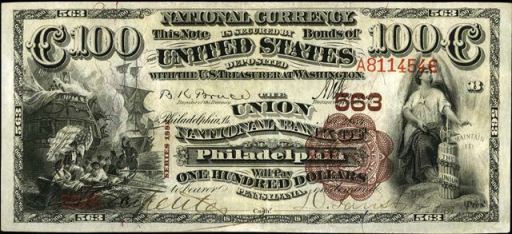The Bowery National Bank Of New York
The Bowery National Bank Of New York in New York printed $1,198,180 dollars worth of national currency. Over $1,000,000 face value is a lot of money. However, some types and denominations of currency from this bank could still be rare. This national bank opened in 1865 and stopped printing money in 1889, which equals a 25 year printing period. That is a fairly normal lifespan for a national bank. During its life, The Bowery National Bank Of New York issued 15 different types and denominations of national currency. We have examples of the types listed below. Your bank note should look similar. Just the bank name will be different. For the record, The Bowery National Bank Of New York was located in New York County. It was assigned charter number 1297.
We buy all national currency. Please call or email us for a quote. Sales@AntiqueMoney.com
The Bowery National Bank Of New York in New York printed 11,000 sheets of $5 original series national bank notes. These notes were only printed until 1875. For a national bank to print more than 10,000 means that they were doing a lot of business. Your exact note is likely still rare. The value will be more condition based than rarity based though. Each five dollar original series bank note has a spiked red seal. That is pretty much the only design difference between it and later issues. These are really beautiful notes. One neat thing about these is that the back of each note has a vignette of the corresponding state seal. Some of the state seals are very imaginative. Collecting by state seal was very popular early on in the hobby. Today most collectors are more concerned about bank of issue and condition. Serial number one bank notes are also extremely popular.
Original Series $5 National Bank Note
The Bowery National Bank Of New York printed 2,099 sheets of $10 original series national bank notes. A print range between 1,000 and 2,500 is small. Combine that with something that was printed before 1875 and you can imagine that these notes are few and far between. These notes were issued during the glory days of the national bank note era. Each $10 bill was pen signed by the president and cashier of the bank. Small towns and large cities both issued these notes. Of course the small town issuers tend to be scarcer today. Prices range from $500 to thousands of dollars (and more if the condition and rarity warrant it). Contact us if you need help valuing your bank note.
Original Series $10 National Bank Note
The Bowery National Bank Of New York also printed 2,099 sheets of $20 original series national bank notes. That issue number may or may not sound like a lot of sheets depending on your experience with collectible currency. However, all original series $20 bills are rare. The production amount is irrelevant when it comes to values. These seem like common issues until you want to buy one. These just aren’t readily available from rare banks in very fine or better condition. We definitely feel like these are undervalued in today’s market.
Original Series $20 National Bank Note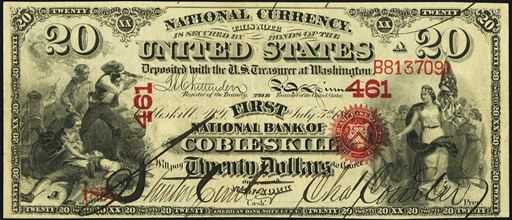
The Bowery National Bank Of New York also printed 967 sheets of $50 original series national bank notes. The printing number for original series $50 bills is irrelevant. There are only about 35 known to exist from all banks in the country. Despite being extremely rare, condition is still very important. Lots of first charter fifty dollar bills are heavily circulated; there are significant premiums for anything that grades extremely fine or higher.
Original Series $50 National Bank Note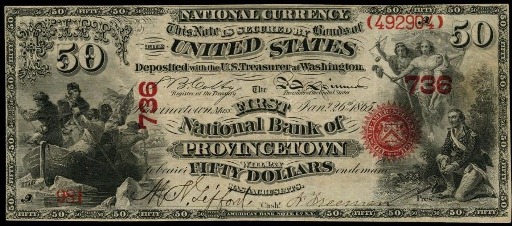
The Bowery National Bank Of New York also printed 967 sheets of $100 original series national bank notes. The same piece of advice applies here as it does to first charter fifties. These are rare enough to the point that printing numbers don’t matter. The same condition guidelines apply to original series $100 bank notes. These traded hands frequently and are often found in “well-used” states today. As with other bank notes, there can be huge price gaps between different grade points.
Original Series $100 National Bank Note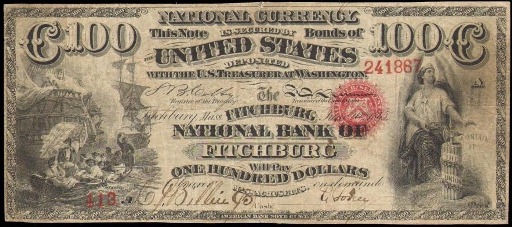
The Bowery National Bank Of New York also printed 9,000 sheets of $5 series of 1875 national bank notes. A print range between 5,000 and 10,000 is a pretty high number. But you have to remember we are talking about bank notes from the 1870s and 1880s. Even banks with high issue numbers could be rare today. Series of 1875 $5 bills are some of the most commonly encountered bank notes from the first charter series. Only the original series $1 bill is more available. Some banks exclusively issued five dollar bills. So if you want an example from one of those banks then you don’t have many options. These notes have a rounded red seal and red serial numbers. They also all have a red charter number.
Series of 1875 $5 National Bank Note
The Bowery National Bank Of New York also printed 3,200 sheets of $10 series of 1875 national bank notes. Hundreds of banks had sheet outputs between 2,500 and 5,000. That is pretty typical for a medium sized national bank in the 1870s. The two vignettes seen on 1875 $10 bank notes are “Franklin and Electricity” and “America Seizing Lightning”. These notes occasionally confuse novices because the year 1752 is printed on them. That is when Benjamin Franklin discovered electricity. It has nothing to do with when these bank notes were issued. The back of each $10 bill has “DeSoto Discovering the Mississippi.”
Series of 1875 $10 National Bank Note
The Bowery National Bank Of New York also printed 3,200 sheets of $20 series of 1875 national bank notes. The exact number of series of 1875 $20 national bank notes printed by this bank is good to know. Don’t expect a high number to lower the value or a small number to increase the value. These notes are scarce enough on their own that the stats don’t really matter. Twenty dollars was a lot of money between 1875 and 1901, which is the time period in which these were printed. These just weren’t saved in high numbers.
Series of 1875 $20 National Bank Note
The Bowery National Bank Of New York also printed 600 sheets of $50 series of 1875 national bank notes. The printing number for original series $50 bills is irrelevant. There are only about 35 known to exist from all banks in the country. To make matters worse, these are not being discovered much at all these days. The supply is pretty constant, as is the demand. Prices start at about $10,000 and can go up sharply from there.
Series of 1875 $50 National Bank Note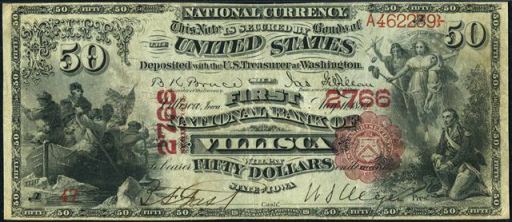
The Bowery National Bank Of New York also printed 600 sheets of $100 series of 1875 national bank notes. There are currently only about 70 series of 1875 $100 national bank notes known to exist. So the sheet output is really only included for factual purposes – it won’t affect values. The actual value is based on condition and bank of issue. If you don’t know how to grade currency, then send us pictures of what you have. We can help you grade and value any national bank note. Of course series of 1875 $100 bank notes would be a treat to see.
Series of 1875 $100 National Bank Note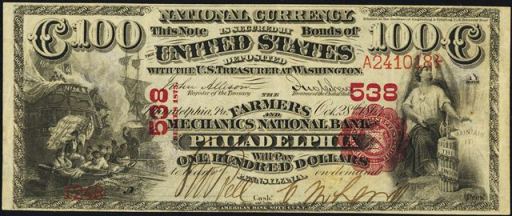
The Bowery National Bank Of New York also printed 6,479 sheets of $5 1882 brown back national bank notes. A print range between 5,000 and 10,000 suggests that there should be at least a couple of notes known to exist. You can take the total number of sheets printed and multiply that number by four to get the exact number of 1882 $5 brown back bank notes this bank issued. Each note has a portrait of James Garfield on the left hand side of the bill. These are very popular with collectors because they have different text layouts. Some notes are worth as little as a few hundred dollars, but most are worth a good deal more.
Series of 1882 $5 Brown Back
The Bowery National Bank Of New York also printed 2,028 sheets of $10 1882 brown back national bank notes. That sheet output number is small. Don’t expect too many of these to be available to collectors. There were three $10 bills printed on a single sheet of 1882 brown backs. The design of the bill is similar to all earlier ten dollar national bank notes. The nickname comes from the fact that these bills have a brown seal and brown overprint. Despite saying series of 1882, these were actually printed by some banks up until 1908. The date you see in cursive relates to when the bank first started issuing brown back notes.
Series of 1882 $10 Brown Back
The Bowery National Bank Of New York also printed 2,028 sheets of $20 1882 brown back national bank notes. As you can see, the sheet output is the same for $20 brown backs as it is for $10 brown backs. There was only one $20 brown back printed on a sheet. So the sheet output also equals the total note output. One neat thing about all brown backs is that they each have a different back design based on which state issued them. The back left hand side of the note shows the state seal of which ever state the national bank was located in. Generally speaking, 1882 $20 brown backs are pretty difficult to locate. They typically were printed in small numbers and they don’t have a great survival rate.
Series of 1882 $20 Brown Back
The Bowery National Bank Of New York also printed 448 sheets of $50 1882 brown back national bank notes. Fifty dollar 1882 brown backs are few and far between. When the print number is under 1,000 like this bank then there is a great chance that you have a very rare bank note. The most common 1882 $50 brown backs are worth about $5,000. However, some can be worth more than $10,000 based on condition, serial number, and bank of issue.
Series of 1882 $50 Brown Back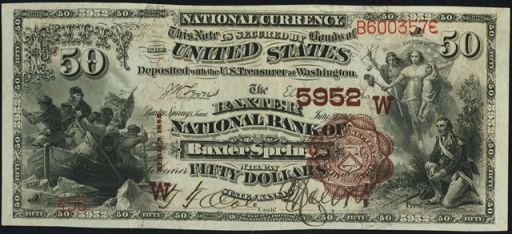
The Bowery National Bank Of New York also printed 448 sheets of $100 1882 brown back national bank notes. High denomination $50 and $100 brown backs were printed on the same sheet. So the number of sheets printed also equals the number bills printed for each denomination. You can see that $100 brown backs are extremely scarce on this bank. We are very interested in purchasing $100 1882 brown back national bank notes. We have paid more than $15,000 for some examples. Send us pictures of what you have and we will respond quickly with an appraisal and offer.
Series of 1882 $100 Brown Back